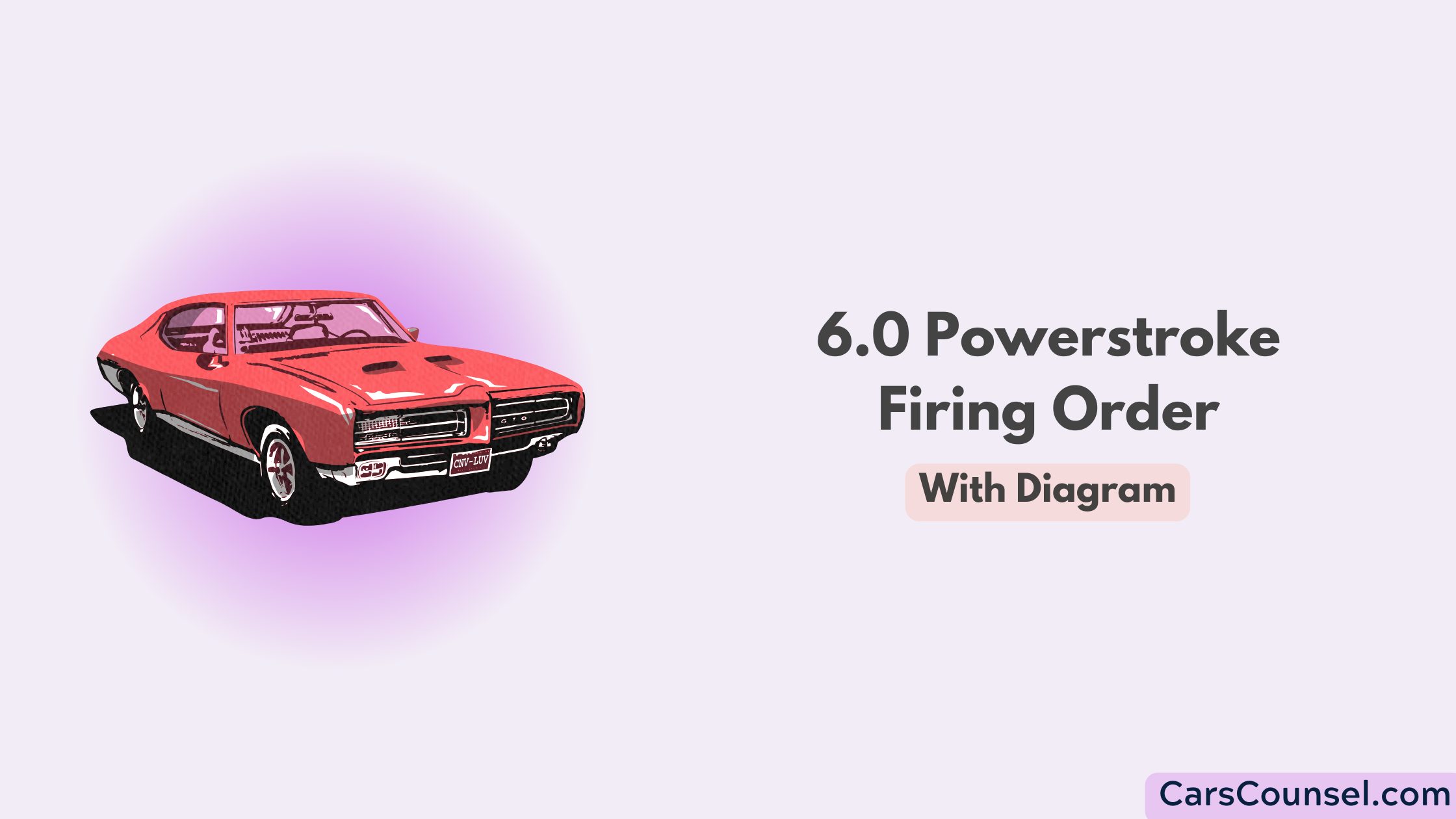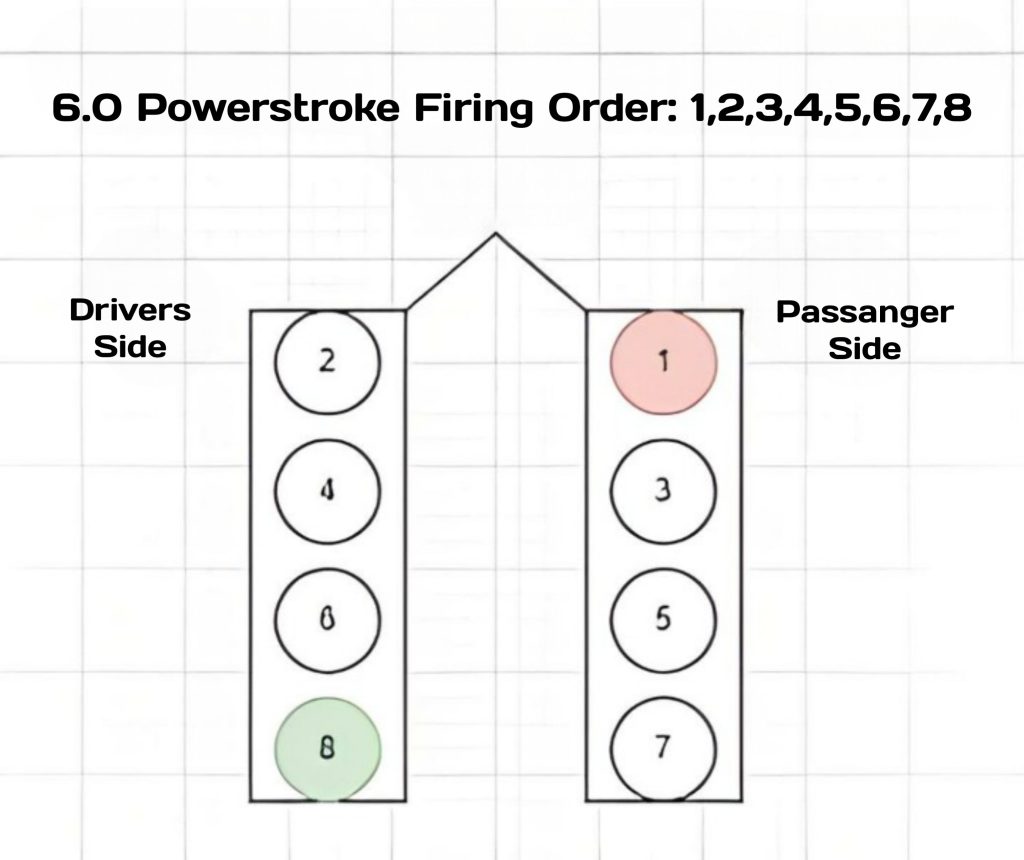Your 6.0 Powerstroke engine operates on a firing order of 1-2-7-3-4-5-6-8. This order is crucial for optimized engine performance; deviation can result in a performance drop or even damage.

Keep in mind that this order applies to a V8 diesel engine, with the right side of cylinders labeled as 2-4-6-8 and the left as 1-3-5-7. Alongside the firing order, several components like fuel injectors, engine wiring, and the Engine Control Module play significant roles. You’ll find that there’s much more to discover about the relationship between these components and the firing sequence as you proceed.
Quick Navigation
Key Takeaways
- The 6.0 Powerstroke Firing Order is 1-2-7-3-4-5-6-8, with right side cylinders as 2-4-6-8 and left side as 1-3-5-7.
- This firing order is integral for engine performance, longevity, and the reduction of vibration.
- Misfires can occur from deviations in the firing order due to faulty fuel injectors or engine wiring issues.
- The firing order should be checked annually or every 12,000 miles using diagnostic tools like a timing light or cylinder balance test.
- For accurate timing, Ford specifies camshaft timing at 4 degrees BTDC and crankshaft timing at 1 degree BTDC.
Understanding 6.0 Powerstroke Firing Order

To fully understand the concept of the 6.0 Powerstroke firing order, it’s important to first realize that this specific engine is a V8 diesel engine equipped with 8 cylinders. The cylinder arrangement on the right side is 2-4-6-8 and on the left side is 1-3-5-7.
The sequence of firing, important for best engine performance, is 1-2-7-3-4-5-6-8. Each cylinder fires in this exact order, contributing to the smooth operation of the engine. The accuracy of this firing sequence is crucial, as any deviation can cause a drop in performance or even engine damage.
Applicability of Firing Order
While you’re harnessing the knowledge of your engine’s firing sequence, keep in mind that this specific order applies to several vehicle types, not just your own. Learning about the firing order isn’t just about performance tuning; it’s also critical in troubleshooting and maintaining engine efficiency.
Let’s consider the applicability of your engine’s firing order:
- It’s essential in performance tuning. By knowing the firing order, you can diagnose and fix misfires, enhancing your vehicle’s performance.
- Troubleshooting becomes a breeze. This knowledge aids in identifying engine issues, which can significantly reduce your vehicle’s downtime.
- Regular maintenance relies on it. Adhering to the correct firing order ensures smooth engine operation, improving longevity and efficiency.
Essential Torque Specifications
Understanding the essential torque specifications for your 6.0 Powerstroke engine is a key part of ensuring efficient performance and longevity. These torque values, set by the manufacturer, are crucial to engine efficiency and must be adhered to during maintenance or repair tasks.
These include main cap bolts (112-157 ft.-lbs), connecting rod bolts (80 ft.-lbs), rocker arms studs (78-120 ft.-lbs), oil pump bolts (85 ft.-lbs), and the harmonic damper bolt (30 ft.-lbs).
Ignoring these precise specifications can result in decreased performance, potential engine damage, and a reduction in the engine’s lifespan. Therefore, always consult your vehicle’s manual or a certified mechanic when dealing with torque specifications to maintain your Powerstroke’s efficient performance and durability.
Timing for 6.0 Powerstroke Engine
Getting your 6.0 Powerstroke engine’s timing just right is essential for peak performance and engine longevity. The 6.0 Powerstroke timing is a critical aspect of your engine’s operation that directly impacts its efficiency.
Here are some key details about this process:
- Ford specifies timing at 4 degrees Before Top Dead Center (BTDC) for the camshaft and 1 degree BTDC for the crankshaft.
- Adjusting the timing requires a specialized timing tool, and it’s not typically a DIY job.
- Incorrect timing can lead to various engine problems, such as reduced power, increased fuel consumption, and even engine damage.
Firing Order in Similar Vehicles
Just as with the 6.0 Powerstroke engine, the firing order plays a significant role in the operation of similar vehicles, such as the Ford F-250, F-350, F-450, F-550, and E-Series vans.
The specific cylinder arrangement and firing sequence directly influence engine performance. In these vehicles, the V8 engine’s cylinders are arranged in a specific order: 1-2-7-3-4-5-6-8. This means the first cylinder fires, then the second, then the seventh, and so on.
This precise order is crucial for best engine output and reduced vibration. Any deviation can cause misfires, leading to potential damage and decreased performance. Therefore, understanding and maintaining the correct firing order in these vehicles is integral to their operation and longevity.
Frequency of Firing Order Checks
While the firing order is typically set during the manufacturing process and seldom requires adjustment, it’s essential to periodically check it, especially when experiencing performance issues or during routine engine maintenance. Maintenance intervals for checking the firing order can vary, but a good rule of thumb is to inspect it at least once a year or every 12,000 miles, whichever comes first.
During these checks, use diagnostic procedures to verify the correct firing order. These might include:
- Checking the spark plug wires for accurate placement.
- Using a timing light to observe the firing sequence.
- Running a cylinder balance test to detect misfires.
Maintain a record of these checks to identify any recurring problems and ensure peak performance.
Components Influencing Firing Order
Beyond the regular checks and maintenance, several components can significantly influence the firing order of your Powerstroke 6.0 engine. Misfires, often a big concern for vehicle owners, can be attributed to faulty fuel injectors. Precise fuel injection is essential for an accurate firing order, so misfire troubleshooting should be a routine part of your maintenance checks.
Your engine’s wiring and connectors, the electrical components, also play an important role in maintaining the correct firing order. Damaged wires or loose connections can cause misfires and disrupt the firing sequence. Moreover, the Engine Control Module (ECM) governs the firing order. Any malfunction in the ECM can lead to a wrong firing sequence, affecting your engine’s performance. Always make sure these components are functioning correctly to keep your engine running smoothly.
About the Author: Jake Mayock
With vast experience in automotive journalism, teaching, and editing, Jake Mayock is a trusted authority in understanding the intricate details of a vehicle’s firing order. His automotive expertise runs deep, with particular emphasis on engine performance and maintenance.
Here are few highlights of Jake’s career:
- He’s spent years dissecting the mechanics of various engines, understanding their firing orders, and explaining the impact on performance.
- Jake has taught numerous automotive classes, sharing his knowledge and passion with the next generation of car enthusiasts.
- As an editor, Jake made significant contributions to several car magazines, ensuring accuracy and relevancy of the information.
In essence, Jake’s technical, detailed, and accurate approach to automotive journalism makes him a reliable source for your engine performance queries.
Conclusion
Well, that’s a wrap on the 6.0 Powerstroke firing order. Now, you’re armed with the essential knowledge to keep your engine firing on all cylinders.
Remember, timing is everything, and a misfire can throw a wrench in your plans. Keep this guide handy for your next tune-up.
As they say, knowledge is power, and with this information, you’re sure to rev up your engine’s performance and efficiency. Keep your wheels turning and your engine burning bright!

